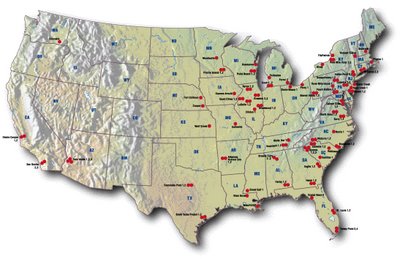Nuclear Plants
 A beautiful picture. I like the contrast of the green leaves and the concrete of the Nuclear Plant's cooling tower.
A beautiful picture. I like the contrast of the green leaves and the concrete of the Nuclear Plant's cooling tower.


A map of all the nuclear facilities in the U.S.
Nuclear energy acually creates the cheapest energy of all electricity producers, with the exception of Hydro. One pound of uranium produces about the same amount of energy as that produced from 3,000,000 pounds of Coal.
The following is taken from wikipedia:
In 2006 in the United States, there were 104 (69 pressurized water reactors and 35 boiling water reactors) commercial nuclear generating units licensed to operate, producing a total of 101,289 megawatts (electric), which is approximately 20 percent of the nation's total electric energy consumption. The United States is the world's largest supplier of commercial nuclear power. Future development of nuclear power in the U.S. (see the Nuclear Power 2010 Program) was enabled by the Energy Policy Act of 2005 [13]. As of 2005, no nuclear plant had been ordered without subsequent cancellation for over twenty years, thus the desire for programs to promote new construction. However, on September 22, 2005 it was announced that two sites in the U.S. had been selected to receive new power reactors (exclusive of the new power reactor scheduled for INL). Since then, other utilities have taken steps towards ordering new nuclear reactors.
A large nuclear reactor produces 3 cubic metres (25-30 tonnes) of spent fuel each year.[29] As of 2003, the United States had accumulated about 49,000 metric tons of spent nuclear fuel from nuclear reactors.

4 Comments:
The pictures are off a cooling tower, not a smokestack. What you're seeing is river water turned into mist. It would be same at a coal plant.
Yu might find my layman's guide to nuclear power enjoyable. See my blog site.
Hi James, thanks for the info. I'll change the wording accordingly.
I hope you're not including this entry to promote nuclear power! Nukes are the dirtiest source of energy. For more information about this, check these resources:
technology hierarchy or nuclear power explained
Hi Matt. Thanks for the post and the signature! I certainly was not intending to promote nuclear power. However, I will say that I am unsure whether I would prefer a traditional coal burning plant to a nuclear plant. I will click on your links to seek more information on the subject.
Post a Comment
<< Home